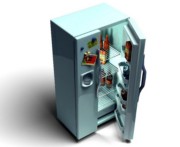How to Avoid Listeria Infections (Listeriosis)?
The best way to avoid foodborne listeria infections (also known as listeriosis) is to always practice good food hygiene in the kitchen. The following paragraphs provide details on how you can reduce your risk of foodborne listeria poisoning.
Tip 1: Maintain Good Kitchen Hygiene Standards

One of the best measures you can take to minimize your risk of foodborne listeriosis is to practice proper kitchen hygiene. This means using hot, soapy water to wash your hands. Also cutting boards, plates, knives and other utensils should always be washed with hot water and soap before and after coming in contact with raw meat or fresh produce. You should also keep your refrigerator clean at all times and immediately clean any liquid spills in the refrigerator, especially spills from products commonly associated with Listeria monocytogenes bacteria (L. monocytogenes), such as deli-style meats. Listeria monocytogenes is one of the few bacteria that are able to grow and multiply on food in the refrigerator.
Tip 2: Separate Foods to Avoid Cross-Contamination
In addition to sanitizing your cutting boards and other kitchen utensils before and after use, you should always cut raw meat on separate cutting boards from cooked meat, vegetables or other foods. This helps prevent cross-contamination of foods with listeria and other bacteria. You can further reduce the risk of cross contamination by storing raw meat, seafood and poultry in sealed containers on a bottom shelf or in a meat drawer of the refrigerator to prevent their juices from dripping on and contaminating foods that may be consumed raw.
Tip 3: Cook Meats to Proper Temperature
Listeria monocytogenes can inhabit animal intestines without the animal showing any signs of illness. Consequently, meat and dairy products may get contaminated by listeria without the producer knowing it.
Luckily, listeria bacteria can be destroyed by cooking or other heating methods such as pasteurization. In order to destroy the pathogenic bacteria, heat foods to safe temperatures. People who are in the high-risk groups for listeriosis (e.g. pregnant women, elderly with weakened immune systems) are usually advised to cook — until steaming hot — all cold cuts, luncheon meats, other deli-style meats, and poultry. The 2005 FDA Food Code recommends to cook the most potentially hazardous foods to an internal temperature of 165°F or above, for 15 seconds.
What Are Listeriosis and Listeria?
Listeria infection (aka listeriosis) is an illness usually caused by the consumption of food contaminated with Listeria monocytogenes (L. monocytogenes) bacteria. In healthy people, listeriosis may have few or no symptoms. In individuals at particular risk (pregnant women, the elderly) symptoms may include headache, fever, aches, pains and tiredness. The illness may also progress to a more serious form, such as meningitis (brain infection) and septicaemia (blood poisoning). In some cases, the listeria infection can be serious enough to be a threat to life.
Potential food sources of Listeria monocytogenes include soft mould-ripened cheeses, milk, coleslaw, pate, raw meat, poultry, seafood, luncheon meats, cold cuts, cantaloupe melons, romaine lettuce and other raw foods that may have been contaminated by the bacteria.
Don't Miss This
 Pacific Salmon: Radioactive or Safe to Eat?Should we be worried about the cesium levels in Pacific salmon after the nuclear disaster in Fukushima?
Pacific Salmon: Radioactive or Safe to Eat?Should we be worried about the cesium levels in Pacific salmon after the nuclear disaster in Fukushima?

